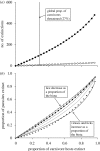The sixth mass coextinction: are most endangered species parasites and mutualists?
- PMID: 19474041
- PMCID: PMC2817118
- DOI: 10.1098/rspb.2009.0413
The sixth mass coextinction: are most endangered species parasites and mutualists?
Abstract
The effects of species declines and extinction on biotic interactions remain poorly understood. The loss of a species is expected to result in the loss of other species that depend on it (coextinction), leading to cascading effects across trophic levels. Such effects are likely to be most severe in mutualistic and parasitic interactions. Indeed, models suggest that coextinction may be the most common form of biodiversity loss. Paradoxically, few historical or contemporary coextinction events have actually been recorded. We review the current knowledge of coextinction by: (i) considering plausible explanations for the discrepancy between predicted and observed coextinction rates; (ii) exploring the potential consequences of coextinctions; (iii) discussing the interactions and synergies between coextinction and other drivers of species loss, particularly climate change; and (iv) suggesting the way forward for understanding the phenomenon of coextinction, which may well be the most insidious threat to global biodiversity.
Figures


Similar articles
-
The assembly and disassembly of ecological networks.Philos Trans R Soc Lond B Biol Sci. 2009 Jun 27;364(1524):1781-7. doi: 10.1098/rstb.2008.0226. Philos Trans R Soc Lond B Biol Sci. 2009. PMID: 19451127 Free PMC article. Review.
-
Mutualistic interactions reshuffle the effects of climate change on plants across the tree of life.Sci Adv. 2019 May 15;5(5):eaav2539. doi: 10.1126/sciadv.aav2539. eCollection 2019 May. Sci Adv. 2019. PMID: 31106269 Free PMC article.
-
Mutualistic strategies minimize coextinction in plant-disperser networks.Proc Biol Sci. 2017 May 17;284(1854):20162302. doi: 10.1098/rspb.2016.2302. Proc Biol Sci. 2017. PMID: 28490622 Free PMC article.
-
Current constraints and future directions in estimating coextinction.Conserv Biol. 2010 Jun;24(3):682-90. doi: 10.1111/j.1523-1739.2009.01398.x. Epub 2010 Jan 7. Conserv Biol. 2010. PMID: 20067486
-
Parasites at Risk - Insights from an Endangered Marsupial.Trends Parasitol. 2018 Jan;34(1):12-22. doi: 10.1016/j.pt.2017.09.001. Epub 2017 Oct 3. Trends Parasitol. 2018. PMID: 28986107 Review.
Cited by
-
The fundamental benefits of multiplexity in ecological networks.J R Soc Interface. 2022 Sep;19(194):20220438. doi: 10.1098/rsif.2022.0438. Epub 2022 Sep 28. J R Soc Interface. 2022. PMID: 36167085 Free PMC article.
-
Generalist parasites persist in degraded environments: a lesson learned from microsporidian diversity in amphipods.Parasitology. 2022 Apr 8;149(7):1-10. doi: 10.1017/S0031182022000452. Online ahead of print. Parasitology. 2022. PMID: 35485747 Free PMC article.
-
The Endophytic Mycobiome of European Ash and Sycamore Maple Leaves - Geographic Patterns, Host Specificity and Influence of Ash Dieback.Front Microbiol. 2018 Oct 24;9:2345. doi: 10.3389/fmicb.2018.02345. eCollection 2018. Front Microbiol. 2018. PMID: 30405540 Free PMC article.
-
Spatial and topical imbalances in biodiversity research.PLoS One. 2018 Jul 5;13(7):e0199327. doi: 10.1371/journal.pone.0199327. eCollection 2018. PLoS One. 2018. PMID: 29975719 Free PMC article.
-
Coprolites reveal ecological interactions lost with the extinction of New Zealand birds.Proc Natl Acad Sci U S A. 2018 Feb 13;115(7):1546-1551. doi: 10.1073/pnas.1712337115. Proc Natl Acad Sci U S A. 2018. PMID: 29440415 Free PMC article.
References
-
- Altizer S., Nunn C. L., Lindenfors P.2007Do threatened hosts have fewer parasites? A comparative study in primates. J. Anim. Ecol. 76, 304–314 (doi:10.1111/j.1365-2656.2007.01214.x) - DOI - PubMed
-
- Bascompte J., Jordano P.2007Plant-animal mutualistic networks: the architecture of biodiversity. Annu. Rev. Ecol. Evol. Syst. 38, 567–593 (doi:10.1146/annurev.ecolsys.38.091206.095818) - DOI
-
- Bond W. J.1994Do mutualisms matter: assessing the impact of pollinator and disperser disruption on plant extinction. Phil. Trans. R. Soc. Lond. B 344, 83–90 (doi:10.1098/rstb.1994.0055) - DOI
-
- Breitbart M., Hewson I., Felts B., Mahaffy J. M., Nulton J., Salamon P., Rohwer F.2003Metagenomic analyses of an uncultured viral community from human feces. J. Bacteriol. 185, 6220–6223 (doi:10.1128/JB.185.20.6220-6223.2003) - DOI - PMC - PubMed
-
- Brook B. W., Sodhi N. S., Ng P. K. L.2003Catastrophic extinctions follow deforestation in Singapore. Nature 424, 420–423 (doi:10.1038/nature01795) - DOI - PubMed
Publication types
MeSH terms
LinkOut - more resources
Full Text Sources

